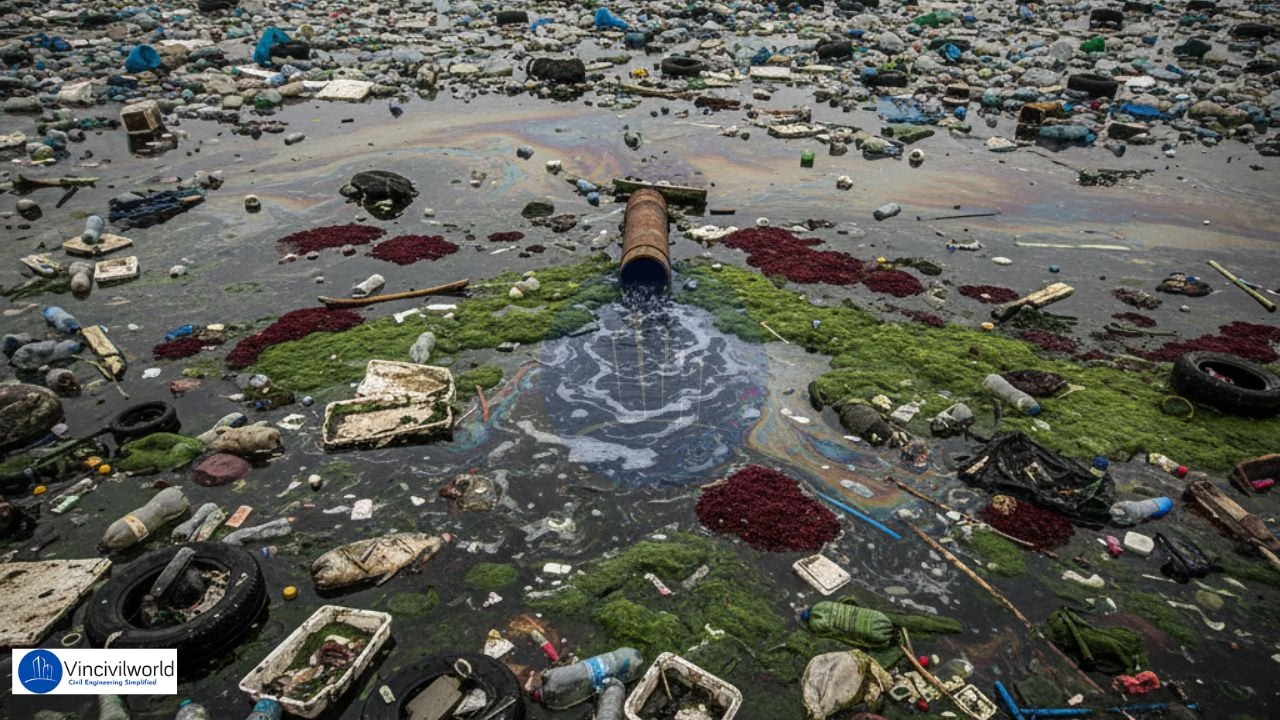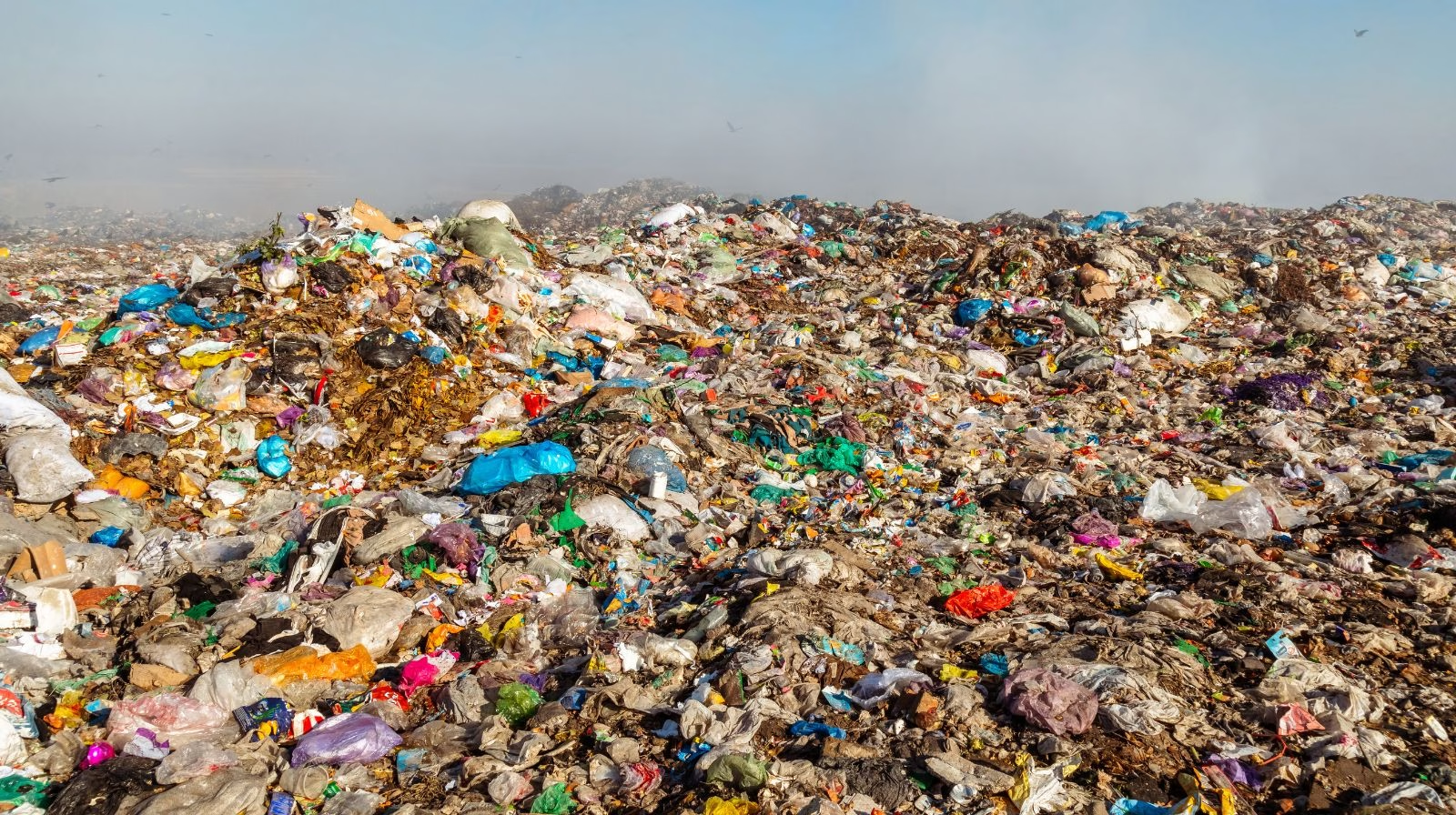Water pollutants are substances that reduce the quality of water and make it unsuitable for drinking, domestic use, agriculture, or aquatic life. They enter water bodies through common activities such as sewage disposal, industrial discharge, agricultural runoff, and urban development. Some pollutants are visible, while others dissolve in water and remain unnoticed for long periods. Over time, these contaminants lead to serious water pollution effects, including ecosystem damage and risks to human health. Understanding the water pollutants definition, along with water pollution causes, helps in identifying major water pollutants sources. By recognizing different water pollution types and linking water pollution causes and effects, engineers and planners can design effective control and treatment strategies. This article explains water pollutants in a clear and practical manner, focusing on their sources, types, causes, and effects on water quality and the environment.
Water Pollutants kill more people every year than from all forms of violence including war, according to the UNDESA. Every day, 2 million tons of sewage, industrial, and agricultural waste reaches water bodies all over the world. With the growth of the human population, industrial and agricultural activities the hydrological cycle got disrupted. As a result, declining water quality has become a global issue of concern.
We will define the different water pollutants, explore the primary water pollutants sources and underlying water pollution causes, and detail the significant water pollution effects on our world. You’ll gain a comprehensive understanding of how these substances, which include pathogens, toxic chemicals, and excessive nutrients, enter and compromise our precious water bodies.
Table of contents
Water Pollutants Definition
The water pollutant definition describes substances that lower water quality and make it unsafe for human use and aquatic life. These substances include organic and inorganic chemicals as well as microbes released from farms, cities, and industrial areas. According to the water pollutant definition, any material that alters the natural physical, chemical, or biological condition of water is considered a pollutant. Water is often called the universal solvent because it dissolves more substances than any other liquid. This property makes water extremely useful, but it also allows harmful compounds to dissolve easily and spread quickly, leading to widespread water pollution.
Sources of water pollutants
The sources of water pollutants refer to activities and processes that introduce harmful substances into water bodies. Identifying the sources of water pollutants helps in controlling contamination and planning effective water pollution prevention strategies.
- Point Source Water Pollutants
- Non-Point source Water Pollutants
Point Source
Point source water pollutants originate from a single, identifiable source where pollutants enter a water body directly. Common examples include leaking septic systems, chemical or oil spills, illegal industrial discharges, and wastewater treatment plant outlets. Although point source water pollution begins at one location, it can contaminate long stretches of rivers, lakes, and even oceans if not controlled.
Examples of Point Source Water Pollutants
- Industrial effluent discharge pipes
- Wastewater treatment plant outlets
- Oil refinery discharges
- Chemical spills and oil spills
- Leaking septic tanks
- Power plant cooling water discharge
Non-Point Source
Non-point source water pollutants arise from dispersed sources rather than a single discharge point. These pollutants are carried into water bodies mainly through runoff, making them difficult to identify and control. Agricultural runoff, stormwater flow, and land-based debris are common contributors to non-point source pollution.
Examples of Non-Point Source Water Pollutants
- Agricultural runoff containing fertilizers and pesticides
- Stormwater runoff from roads and urban areas
- Pond ash from ash dykes
- Soil erosion carrying sediments
- Debris and waste blown into streams
- Runoff from construction sites
This classification helps in designing effective water pollution control and management strategies.
Types of water pollutants
The types of water pollutants can be grouped based on how they affect water quality and aquatic life. These include physical pollutants such as sediments and suspended solids that make water cloudy, chemical pollutants like heavy metals and pesticides that change water chemistry, and biological pollutants such as bacteria and viruses that pose health risks. In addition, thermal pollutants increase water temperature, while radioactive pollutants come from specialized industrial or nuclear sources. Understanding the types of water pollutants helps in identifying problems early and choosing appropriate treatment and prevention methods to protect water bodies.
Water pollutant types – Classification by nature
- Chemical pollutants
- Biological pollutants
- Physical Pollutants
- Thermal Pollutants
| Chemical Pollutants | Biological Pollutants | Physical Pollutants | Thermal Pollutants |
|---|---|---|---|
| Heavy metals (lead, mercury, arsenic) | Bacteria (E. coli, Salmonella) | Suspended solids | Heated discharge from power plants |
| Pesticides and herbicides | Viruses (Hepatitis, Rotavirus) | Sediments and silt | Cooling water effluents |
| Industrial chemicals | Protozoa (Giardia, Entamoeba) | Plastic waste | Sudden temperature rise |
| Petroleum products and oil | Algae (harmful blooms) | Turbidity-causing particles | Reduced dissolved oxygen |
| Acids and alkalis | Fungi | Floating debris | Stress on aquatic organisms |
| Nitrates and phosphates | Parasites | Soil erosion materials | Ecosystem imbalance |
| Detergents and solvents | Pathogenic microbes | Construction waste | Altered aquatic habitat |
Water pollutant types – Functional or impact based classification
- Oxygen Demanding Wastes
- Disease-causing Agents
- Synthetic Organic Compounds
- Plant Nutrients
- Inorganic Chemicals and Minerals
- Sediments
- Radioactive Substances
- Thermal Discharges
- Oil
Oxygen Demanding Wastes
- Organic wastes which demand a high amount of dissolved oxygen for their microbial decomposition are referred to as oxygen demanding wastes.
- Such kind of organic wastes arises from sewage, food processing plants, tanning operations etc.
- Biochemical Oxygen Demand or BOD measures the water pollution potential of the organic waste.
- The amount of dissolved oxygen (DO) required by aerobic biological organisms to decompose the organic waste present in a given water sample at a particular temperature over a given time period is known as biochemical oxygen demand (BOD).
- Oxygen demand is directly proportional to the organic waste concentration in the water.
- In other words, the higher the BOD of the wastewater, the higher is the amount of oxygen required for the degradation of waste.
- Oxygen demanding wastes pose a hazard to aquatic life by using up the dissolved oxygen in the water for its degradation.
Disease-causing Agents
Sewage and wastes from farms and industries like tanning and meat packaging industries carry pathogens into the water bodies. As a result, water contains bacteria which causes cholera, typhoid, amoebic dysentery and viruses responsible for polio, coxsackie fever. These pathogens enter the human body through drinking water and other activities.
Escherichia coli is a harmless bacteria found in high concentrations in human faeces. They are used to assess the hygienic quality of water. Since the coliforms usually travel together with the pathogens, a high concentration of E. coli indicates faecal contamination and the presence of pathogens.
Synthetic Organic Compounds
- Pesticides, insecticides and herbicides used in the crop fields reach the water bodies via surface runoff from agricultural lands and stormwater.
- The commonly used chlorinated pesticides include aldrin, dieldrin and DDT.
- They are highly stable, volatile and soluble in fats and oils and they accumulate in the bodies of aquatic organisms.
- Through biological magnification, it gets more concentrated from one trophic level to the next in the food chain.
- Fishes and predatory birds are the victims of pesticide pollution. For instance, dieldrin affects the calcium metabolism in predatory birds and leads to thinning of their eggshells.
- Through drinking water and consumption of fishes, pesticide residues enter the human body.
- The surfactants present in detergents create foam in water bodies and hamper the oxygen absorption of water. And, higher levels of phosphate act as a plant nutrient and generate eutrophic conditions.
Plant Nutrients
- Phosphates, nitrates and ammonia are the major plant nutrients. They find their way into water bodies via effluents from fertilizer, food and textile industries.
- As the concentration of these nutrients increases in the water bodies, algae absorbs them and grows excessively, resulting in eutrophication.
- The process through which a water body gets enriched in dissolved nutrients is known as eutrophication.
- This leads to algal bloom and develops a green slime layer over the surface of the water.
- Therefore, sunlight can’t reach the bottom of the water bodies and this hampers atmospheric reoxygenation.
- After that, the algal growth dies down and its degradation results in anaerobic conditions.
- An anaerobic bacterium, Clostridium botulinum can flourish in this environment. It secretes a powerful toxin, botulinum that kills the algae feeding birds and humans.
- Nitrate enters the human body through drinking water. It forms a complex, methaemoglobin which reduces the oxygen-carrying capacity of the blood. This leads to a fatal condition called methaemoglobin anaemia or blue baby disease.
Inorganic Chemicals and Minerals
The water pollutants like inorganic salts, mineral acids, finely divided metals and metal compounds fall under the category of inorganic chemicals and minerals. Municipal and industrial wastewater and mine runoffs are the main sources of these pollutants. Sulphur and coal mining leads to acid mine drainage consisting of sulphuric acid and iron compounds. In addition to this, tanneries, textiles and coke oven operations release alkalies to the water bodies.
- Cadmium, Chromium, Lead, Mercury and Silver are metals found in industrial wastewater that requires serious attention.
- Effluents from chemical plants, electroplating and textiles generate cadmium. The use of cadmium contaminated water for irrigation may have been the reason for itai-itai disease in Japan.
- Wastewaters from aluminium anodizing, paint and dye industries, ceramic and glass industry brings both trivalent and hexavalent chromium to the water bodies.
- Lead is present in industrial effluents from battery manufacture, printing and painting operations. It is a cumulative poison and concentrates mainly on the bones.
- The most toxic aquatic pollutant is mercury owing to its rapid methylation in the aquatic environment. It builds up in the food chain and reaches toxic levels at the top of the trophic level.
- Severe mercury poisoning causes Minamata disease, a neurological disease. Industrial effluents from chlorine and caustic soda, fertilizers and pesticides are the main culprits of mercury pollution.
- The main sources of silver in wastewater are electroplating and photographic operations.
Sediments
Soil, sand and mineral particles reaching the aquatic environment through floodwaters constitute the sediments. The presence of sediments increases the turbidity of water bodies. Therefore, sunlight can’t penetrate to the bottom and its availability to aquatic plants decreases. Moreover, they cause the thickening of fish gills and asphyxiation of the fish and sediments also destroy the spawning sites of fish on the river bed.
Radioactive Substances
The radioactive material used in industrial, medical, or scientific activities creates nuclear waste. Uranium and thorium mining and refining are also sources of nuclear waste. Radium is the most important radioactive waste product and is a health hazard in drinking water.
Thermal Discharges
- Heat is a water pollutant because it reduces the capacity of water to carry dissolved oxygen and raises the rate of metabolism in fish.
- The practice of releasing cooling water from power stations into rivers is a major source of heat since the released water can be up to 15 degrees Celsius warmer than naturally occurring water.
- Firstly, some fish species, such as trout, cannot survive in water with very low dissolved oxygen levels. Secondly, their eggs will not hatch at temperatures higher than 14.5 degree Celsius.
- Moreover, there is a decline in oxygen saturation percentage with the increase in temperature.
- Due to the density difference, hot water forms a separate layer above cold water.
- This prevents the reaeration of the cold water underneath, as it has no atmospheric contact.
- Due to the normal biological activities in the lower layer, the Dissolved Oxygen level falls rapidly and generates anaerobic conditions.
Oil
Every year, nearly half of the estimated 1 million tonnes of oil that enters marine habitats comes from land-based sources such as factories, farms, and towns. In addition, oil can ooze out from the ocean’s depths and eroded sedimentary rocks. Since oil does not dissolve in water and instead forms a thick sludge, it suffocates fish and sticks to the feathers of marine birds, preventing them from flying. Also, it prevents photosynthetic aquatic plants from receiving sunlight.
To sum up, the concentration of pollutants in water can be reduced by treating the effluents. To know more about wastewater treatment methods, please check our blogs,
Wastewater Treatment- Stages and Process full details.
Key Takeaways
- Water pollutants degrade water quality and stem from sewage, industrial discharge, and agricultural runoff.
- Pollutants fall into two main categories: point source, which are traceable to a single location, and non-point source, which are dispersed.
- Major types of water pollutants include oxygen demanding wastes, disease-causing agents, synthetic organic compounds, and inorganic chemicals.
- Water pollution poses serious risks to human health and aquatic life, necessitating effective treatment and control strategies.
- Understanding water pollutants is crucial for designing systems that protect water bodies and improve water quality.
Conclusion
Water pollutants remain one of the most critical environmental challenges affecting human health, ecosystems, and water security. Understanding the water pollutants definition helps identify substances that degrade water quality and make water unsafe for use. By examining water pollutants sources and water pollution causes, it becomes clear that industrial discharge, sewage, agriculture, and urban runoff play major roles in contamination. Different water pollution types, including chemical, biological, physical, and thermal pollutants, contribute to serious water pollutants effects such as ecosystem damage, loss of aquatic life, and waterborne diseases. Effective control, monitoring, and treatment strategies are essential to reduce these impacts. Sustainable water management, stricter regulations, and public awareness can significantly limit pollution levels. Addressing water pollutants in a systematic and responsible manner is vital to protect water resources and ensure safe, clean water for future generations.







